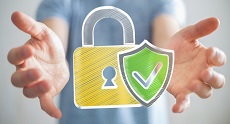
About one in 15 people are victims of identity theft in this country, according to Verizon. And oftentimes, it’s because people can be careless with their private information, lose their wallet or smartphone, leave their mail unguarded, connect to unsecured wireless networks or fall for cyber scams — don’t make these mistakes. Instead, be more cautious about giving out personal information and implement some type of protection to ensure you don’t become a victim.
Here are a few other things you can do to reduce the risk of identity theft.
- Use Different (Strong) Passwords for Each Account
You might be tempted to use the same password for multiple accounts, but you should avoid doing that so that if one of your accounts becomes compromised, you won’t have to change the password to the other accounts you used the same password for.
In addition to using a different password for each account, make sure each one you create is a strong password, meaning no personally identifiable information. It’s best to create a random combination of letters, numbers and special characters (if they’re allowed), and use a password manager to help you keep track of them all. Changing your password every three to six months can also help reduce your chances of becoming a victim of identity theft.
- Review Your Accounts Regularly
Checking your financial statements regularly can help you spot any issues early on and prevent them from becoming huge headaches. Start reviewing your statements for every account you have at any financial institution, which includes bank, credit card and investment accounts. Look for any suspicious or unauthorized activity; if you come across something that doesn’t look quite right, contact your financial institution immediately and let them know about it. Then, freeze your account(s) to prevent any further unauthorized activity.
- Get Identity Monitoring
Checking your credit reports regularly can help you stay a step ahead of things if someone opens an account in your name without your knowledge. Take it a step further by getting some sort of identity monitoring service so you’ll be alerted whenever something like that happens. Identity monitoring can make you aware of any habits or actions you need to change to help prevent identity theft from happening to you.
- Protect Your Personal Information
Preventing identity theft means protecting your personal information from the eyes of potential thieves. That means shredding anything that contains any kind of personal financial information, such as bank or credit card statements. If you have anyone working inside your home, make sure all of your personal and financial records are locked away. Also, avoid leaving your debit or credit card receipts lying around and avoid throwing them away in public. Instead, wait until you get home and shred them.
- Be Careful When Shopping Online
Shopping online can lead to identity theft if you’re not careful. That’s why it’s important that you avoid giving out personally identifiable information whenever you can. Never provide personal information like your birthdate to a site that’s not secure because that makes it easier for people to access that information. A secure website will have “https”, rather than just an “http” in the URL. You can take it a step further and right-click the padlock next to the URL to make sure everything’s up to date.
Taking the Right Security Measures
With the above in mind, you can start taking steps to protect yourself from identity theft. From using different passwords and reviewing your accounts regularly to getting real-time identity monitoring services and protecting your personal information, there are several ways you can go about making sure your private information stays private.
Related posts:






